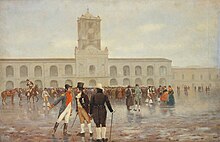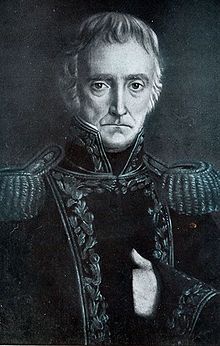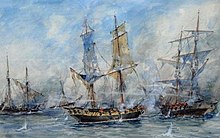Argentine War of Independence
This article possibly contains original research. (April 2022) |
| Argentine War of Independence | |||||||
|---|---|---|---|---|---|---|---|
| Part of the Shooting of Liniers, Jujuy Exodus. | |||||||
| |||||||
| Belligerents | |||||||
|
Republiquetas |
| ||||||
| Commanders and leaders | |||||||
|
Manuel Belgrano José de San Martín Martín Miguel de Güemes † Juan José Castelli José Gervasio Artigas William Brown Carlos María de Alvear | |||||||
The Argentine War of Independence (Spanish: Guerra de Independencia de Argentina) was a secessionist civil war
Background
The territory of modern
In the political structure most authoritative positions were filled by people designated by the Spanish monarchy, most of them Spanish people from Europe, also known as peninsulares, without a strong commitment for South American problems or interests. This created a growing rivalry between the Criollos, white people born in Latin America, and the peninsulares, Spanish people who arrived from Europe (the term "Criollo" is usually translated to English as "Creole", despite being unrelated to most other Creole peoples). Although they were all considered Spanish, and there were no legal distinctions between Criollos and Peninsulares, most Criollos thought that Peninsulares had undue influence in political matters. The ideas of the American and French Revolutions, and the Age of Enlightenment, promoted desires of social change among the criollos. The full prohibition imposed by Spain to trade with other nations was also seen as damaging to the viceroyalty's economy.[citation needed]
The population of Buenos Aires was highly militarized during the
The
The Revolution


The military conflict in Spain worsened by 1810. The city of
Buenos Aires requested the other cities in the viceroyalty to acknowledge the new Junta and send deputies. The precise purpose of these deputies, join the Junta or create a congress, was unclear at the time and generated political disputes later. The Junta was initially resisted by all the main locations around Buenos Aires: Córdoba, Montevideo, Paraguay and the Upper Peru. Santiago de Liniers came out of his retirement in Córdoba and organized an army to capture Buenos Aires, Montevideo had naval supremacy over the city, and Vicente Nieto organized the actions at the Upper Peru. Nieto proposed to José Fernando de Abascal y Sousa, viceroy of the Viceroyalty of Peru at the North, to annex the Upper Peru to it. He thought that the revolution could be easily contained in Buenos Aires, before launching a definitive attack.
Buenos Aires was declared a rogue city by the Council of Regency, which appointed

Armed conflict
The Primera Junta sent military campaigns to the viceroyalty, in order to secure support to the new authorities and retain the authority held as the capital of the viceroyalty. The victories and defeats of the military conflict delimited the areas of influence of the new United Provinces of the Río de la Plata. With the non-aggression pact arranged with Paraguay early on, most of the initial conflict took place in the north, in Upper Peru, and in the east, in the Banda Oriental. In the second half of the decade, with the capture of Montevideo and the stalemate in Upper Peru, the conflict moved to the west, to Chile.[12]
Initial campaigns
The first two military campaigns ordered by the revolutionary Junta in Buenos Aires were launched against
However, the improvised army gathered by Liniers at Cordoba deserted him before battle, so the former Viceroy attempted to flee to the Upper Peru, expecting to join the royalist army sent from the Viceroyalty of Peru to suffocate the revolution at Buenos Aires. Colonel Francisco Ortiz de Ocampo, who led the patriot army, captured Liniers and the other leaders of the Cordoba counter-revolution on 6 August 1810, but, instead of executing them as he was instructed, he sent them back to Buenos Aires as prisoners. As a result, Ocampo was demoted and Juan José Castelli was appointed as the political head of the army. On 26 August, Castelli executed the Cordoba prisoners and led the Army of the North towards the Upper Peru:
- First Upper Peru campaign (1810–1811)
After securing the loyalty of the northwestern Provinces to the May Revolution through elections of representatives to the Junta in Buenos Aires, Castelli sent General
Castelli then proposed to the Buenos Aires Junta to cross the
- Paraguay campaign (1810–1811)
The other militia sent by Buenos Aires was commanded by Manuel Belgrano and made its way up the Paraná River towards the Intendency of Paraguay. A first battle was fought at Campichuelo, where the Patriots claimed victory. However, they were completely overwhelmed at the subsequent battles of Paraguarí and Tacuarí. Thus, this campaign ended in failure as well from a military point of view; however, some months later, inspired on the Argentine example, Paraguay broke its links with the Spanish crown by declaring itself an independent nation:
- First Banda Oriental campaign (1811)

Renewed offensives
The undesired outcomes of the Paraguay and Upper Peru campaigns led the Junta to be replaced by an executive
- Second Upper Peru campaign (1812–1813)
General Manuel Belgrano was appointed as the new commander of the Army of the North. Facing the overwhelming invasion of a royalist army led by General Pío de Tristán, Belgrano turned to scorched-earth tactics and ordered the evacuation of the people of Jujuy and Salta, and the burning of anything else left behind to prevent enemy forces from getting supplies or taking prisoners from those cities. This action is known as the Jujuy Exodus.
Turning against the Triumvirate orders, however, Belgrano decided to fight the royalists at
- Second Banda Oriental campaign (1812–1814)
In early 1812, the truce between Buenos Aires and Montevideo was over, and
The Spanish navy then sought to evade the land blockade by raiding nearby populations on the west bank of the Uruguay river. On 31 January 1813, Spanish troops from Montevideo landed near the town of San Lorenzo, Santa Fe Province, but it was absolutely defeated by the Granaderos unit led by San Martín on February 3. The Battle of San Lorenzo ended further Spanish raids on the west bank of the Paraná river and the Triumvirate awarded San Martín the rank of general.
The Granaderos unit was instrumental in the
One of the first actions of Posadas was to create a naval fleet from scratch, which was to be financed by Juan Larrea, and appointed William Brown as lieutenant colonel and chief commander of it, on March 1, 1814. Against all the odds, on 14 May 1814 the improvised patriot navy engaged the Spanish fleet and defeated it three days later. This action secured the port of Buenos Aires and allowed the fall of Montevideo, which could not stand the siege any more, on 20 June 1814.
The march towards Independence
The fall of Montevideo eliminated the royalist menace from the Banda Oriental and meant the actual end of the Spanish Viceroyalty of the Río de la Plata. Soon afterwards, William Brown was awarded the rank of admiral, and Carlos María de Alvear, who was put in charge of the siege of Montevideo just a few days before the surrender of the city, succeeded his uncle Gervasio Posadas as the Supreme Director of the United Provinces, on January 11, 1815. Alvear, however, was resisted by the troops, so he was quickly replaced, on April 21, by Ignacio Álvarez Thomas through a mutiny. Álvarez Thomas then appointed Alvear as general of the Northern Army, in replacement of José Rondeau, but the officiality did not recognize this and remained loyal to Rondeau:
- Third Upper Peru campaign (1815)
- In 1815, the Northern Army, unofficially commanded by Sipe-Sipe (November 28), the northern territories of the Upper Peru were effectively lost to the United Provinces. However, the Spanish Army could not advance further south as they were successfully stopped at Salta by the Güemesguerrillas from then on.
The unsuccessful outcome of the third Upper Peru campaign would spread rumors in Europe that the May Revolution was over. Furthermore, King Ferdinand VII was restored to the Spanish throne on 1813, so an urgent decision was needed regarding the political status of the United Provinces.
On July 9, 1816, an
Army of the Andes (1814–1818)

In 1814, General José de San Martín had taken command of the
San Martín asked to become the Governor of the
In early 1817, San Martín led the
However, Royalist resistance persisted in southern Chile, allied with the
On March 18, 1818, Osorio led
The Chile campaign is generally considered to be the conclusion of the Argentine War of Independence, as the
Annual commemoration
The Día de la Revolución de Mayo (May Revolution Day) on May 25 is an annual holiday in Argentina to commemorate the First National Government (and the creation of the Primera Junta), one of the significant events in the history of Argentina. These and other events of the week leading to this day are referred to as the Semana de Mayo (May Week).
See also
- Spanish American wars of independence
- Rise of the Argentine Republic
- United Provinces of the Río de la Plata
- Timeline of the Argentine War of Independence
- Argentine Irredentism
References
- ^ Rivera Vivanco, Gabriel (2011). "El apoyo de Chile a la independencia de las Provincias Unidas del Río de la Plata en 1811". Cuaderno de Historia Militar (in Spanish) (7): 7–19.
- ^ Hormazábal Espinosa, Pedro Edo. (2007). "Soldados chilenos en Argentina, la primera cooperación militar en el proceso independentista a partir de 1811". Revista de Historia Militar (in Spanish) (6): 45–50.
- ^ Strachan, Hew (2011). The Changing Character of War. p. 206.
- ^ Kinsbruner, Jay (2000). Independence in Spanish America: Civil Wars, Revolutions, and Underdevelopment.
- ^ Lu, Jing (2018). On State Secession from International Law Perspectives. p. 14.
- ^ Rospide, Santiago Miguel (2021). "¿Por qué los españoles rechazaron la propuesta del General San Martín de coronar un príncipe Borbón en el Perú?". ReDiU, Revista Digital Universitaria del Colegio Militar de la Nación.
- ^ Camogli, p. 23
- ^ Camogli, p. 24
- ^ Camogli, pp. 26–27
- ^ Camogli, pp. 27–28
- ^ Camogli, pp. 29–31
- ^ Camogli, pp. 32–33
Bibliography
- Camogli, Pablo; Luciano de Privitellio (2005). Batallas por la Libertad. Buenos Aires: Aguilar. ISBN 987-04-0105-8.
- ISBN 950-49-1110-2.





